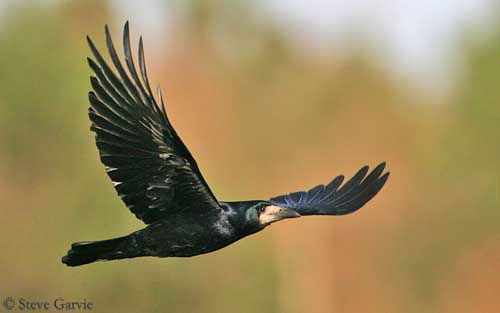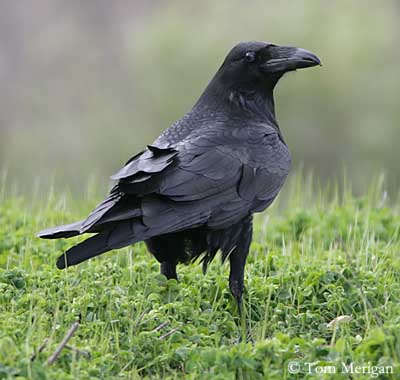
FAMILY CORVIDAE
Nutcrackers, jackdaws, ravens, crows, jays, magpies, ground jays and treepies
The Family Corvidae belongs to the Order Passeriformes. This family gathers several species which voices and actions marked different human cultures centuries ago. They are smart, with excellent memory, curiosity sociability and they are … opportunist! They are able to find solutions and solve problems as in wild or in laboratory experiments.
They occur throughout the world, from the Arctic to the most arid deserts, and at elevation from sea-level up to 6500 metres, just as easily on islands and continents as in urban areas.
Corvids are quite variable in size. The Common Raven (Corvus corax) is the largest with about 70 cm in length and almost 2000 g in weight, whereas the Dwarf Jay (Cyanolyca nana) is the smallest with only 20-23 cm in length and about 40-42 g in weight.
Text by Nicole Bouglouan
Photographers :
Audevard Aurélienn
OUESSANT DIGISCOPING
Bouglouan Nicole
PHOTOGRAPHIC RAMBLE
Chrétien Marc
MURINUS
Jean Michel Fenerole
Photos d’Oiseaux du monde
Garvie Steve
RAINBIRDER Photo galleries
Grey Tom
Tom Grey's Bird Pictures
Patrick Ingremeau
TAMANDUA
Lortie René
http://rlortie.ca/
Merigan Tom
Tom Merigan’s Photo Galleries
Mistry Niraj Vijaykumar
Photo Galleries
Moul Bob
Nature Photography
Peers Jean Michel
JMPN PHOTOGRAPHIE
Jean Marc Rabby
Des Ailes et des Plumes
Callie de Wet
GALERIE
Sources :
HANDBOOK OF THE BIRDS OF THE WORLD Vol 14 by Josep del Hoyo-Andrew Elliot-David Christie - Lynx Edicions –
ISBN: 9788496553507
THE HANDBOOK OF BIRD IDENTIFICATION FOR EUROPE AND THE WESTERN PALEARCTIC by Mark Beaman, Steve Madge - C.Helm - ISBN: 0713639601
THE COMPLETE BOOK OF BRITISH BIRDS – Written by “Royal Society for the Protection of Birds” experts - Préface de Magnus Magnusson - Michael Cady- Rob Hume Editors - ISBN: 0749509112
Wikipedia (Wikipedia, The Free Encyclopedia)

Some basic features are typical of this family, such as the long tarsus which bear scales in front and hard protection behind, the stiffened primary and tail feathers, and the conspicuous nasal bristles extending to the nostril opening. Young are usually unspotted, except in Crested Jay (Platylophus galericulatus).
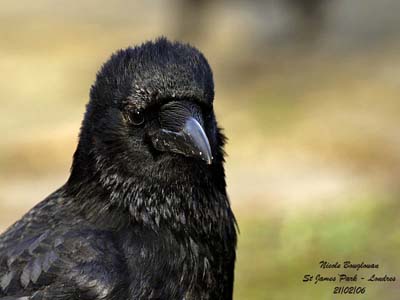
The genus “Corvus” (crows, ravens and jackdaws) usually has black plumage, with some variations including grey and white. Their plumage shows blue, green, purple or silver sheen, but lacks bright colours. However, the black plumage brings social advantages because these birds are more conspicuous in the open areas where they live and contacts between them are easier.
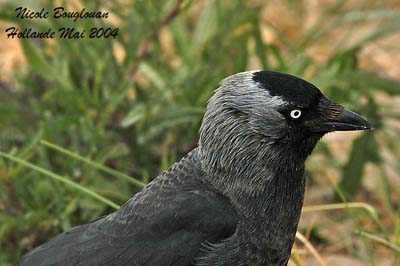
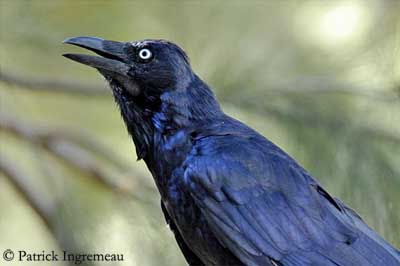
On the other hand, some jays and magpies show colourful and bright plumages. They live closer to the trees and vegetation than crows. The colours allow them to remain in visual contact, and in addition, they often bear developed crest and long peculiar tail making this contact easier.
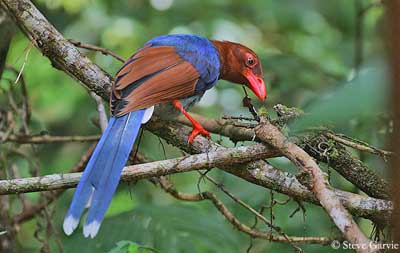
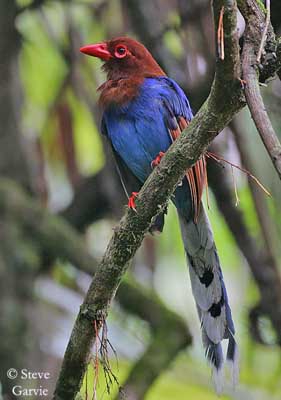
Most of Corvidae have blackish bill, legs and feet.
Female is often smaller than male and the chicks are naked or covered in very sparse down at birth. Juvenile and adult plumages are often similar, with exceptions such as the Yucatan Jay (Cyanocorax yucatanicus) which show different colours.
The wings tend to be rounded and show ten primaries. The tail may short to very long and often rounded too. The bill may vary in size and shape, but it is usually stout and strong, fairly long with slightly hooked tip. Legs and feet are robust.

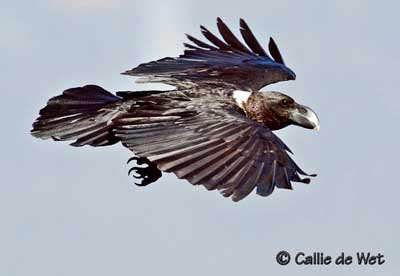
Corvids occur in numerous terrestrial habitats through the world. They are found from tropical wet forests to deserts and from arctic zone to high mountains. They are omnivorous and have high cerebral capacity, helping them to take advantage of numerous opportunities for feeding.
They are able to live in harsh conditions such as the long, cold nights of the higher latitudes, and the high desert’s temperatures.
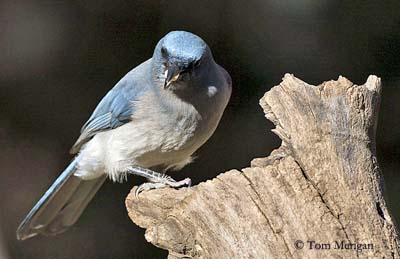
The Grey Jay (Perisoreus canadensis) is a small bird living year-round at high latitudes in North America. This bird saves its energy by entering hypothermic torpor during the cold nights, as the state of hibernation in several animals’ species.
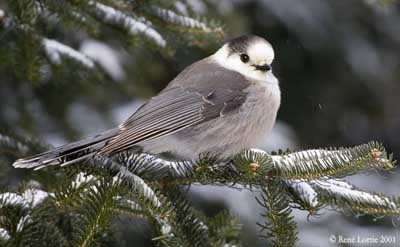
The most widely distributed species is the Common Raven. This bird occupies various habitats, except the dense vegetated areas such as interior of forests, thickets, wetlands with tall vegetation and other similar places. This bird is the symbol of the “wild country”, in contrast with the most part of the genus “Corvus” which often lives near humans, as well in towns and villages as in rural and cultivated fields.
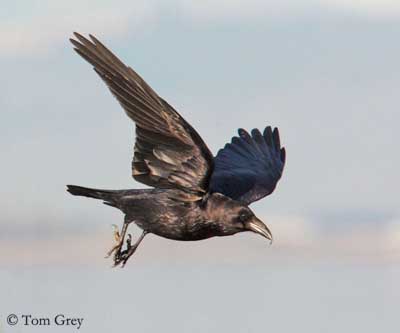
Crows are common in large cities throughout the world. The “highest” species is the Large-billed Crow (Corvus macrorhynchos) which occurs in the Himalayas up to the limit of the tree-line and even beyond. The typical desert species is the Brown-necked Raven (Corvus ruficollis) found from northern Africa to Central Asia. But other species are also able to live in arid regions, including the Fan-tailed Raven (Corvus rhipidurus) from Africa and Middle East, the Chihuahuan Raven (Corvus cryptoleucus) from Mexico, and the Little Crow (Corvus bennetti) from Australia.
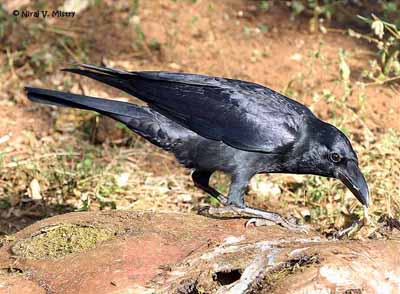
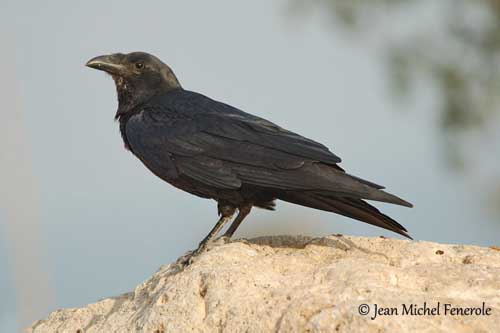
In contrast, the Fish Crow (Corvus ossifragus) is found close to water, marshes or coastal sea-shores.
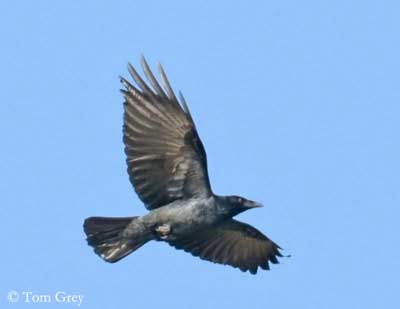
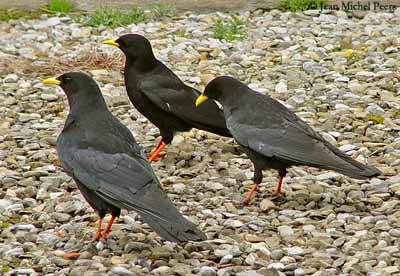
The ground-jays are desert’ species and the Piacpiac (Ptilostomus afer) lives in dry savannahs with scattered trees.
This family occurs in all types of habitats according to the species.
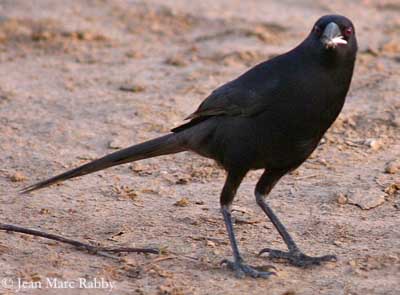
Corvids utter a wide variety of sounds but true songs are rare. Their voice may be described as whistles, harsh notes, nasal and raucous sounds, chatters, barks and clicking notes. There are individual variations and vocal mimicry, but also regional differences.
Most of the calls are used during the breeding season, and each species emits several types of sounds. The repertoire can vary seasonally.
These calls are produced in different situations, and often accompanied by some displays such as rolls or dives on closed wings by Common Ravens in territorial defence.
A pair of American Crows emits calls in duet when proclaiming territory.
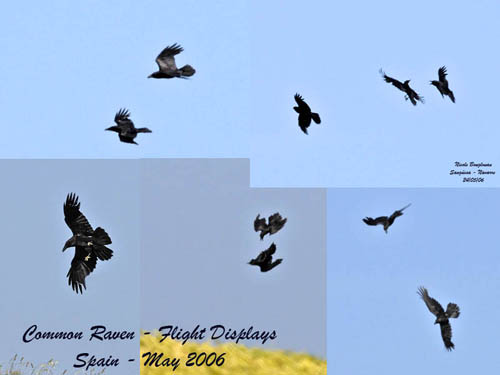
The alarm call is usually sharp, intense and rapid, but when the birds are in flocks and the predator already close to them, the alert sound is soft, making difficult for the intruder to find the noisy bird. This type of behaviour has been studied in Steller’s Jay.
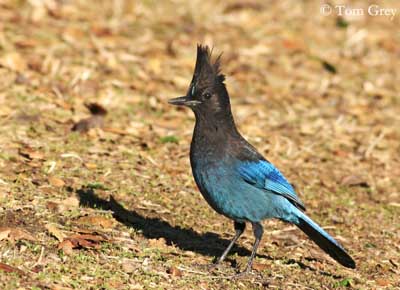
The contact is established within the pair, the family group or the foraging flock by identical notes. The Rook or the Western Jackdaw’s contact call is the most common sound of the repertoire within the breeding colony.
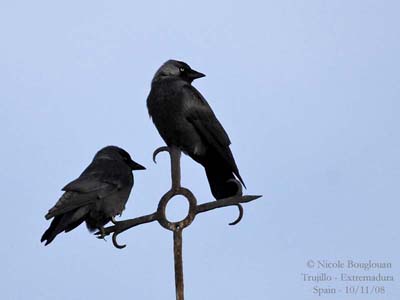
Corvids may mimic a variety of sounds. The Common Raven, the Eurasian Jay and the Eurasian Magpie mimic human voices and whistles. In addition, the Eurasian Jay copies other calls’ species.
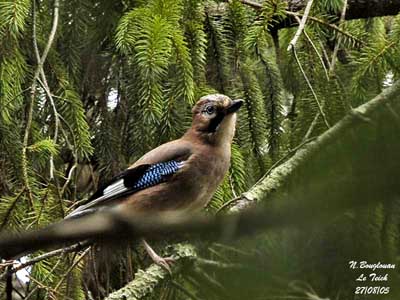
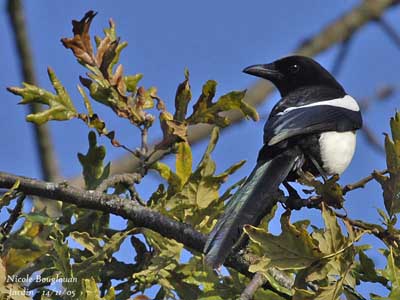
Corvidae do not sing as other members of Order Passeriformes, but they utter complex series of different notes and sounds.
These birds tend to be omnivorous, feeding on animal and vegetable food items. The list is very long! They eat insects, spiders, earthworms, eggs of vertebrates, carrion, cereal grain and other seeds.
Some of them such as the Australian Raven take advantage of nectar flowers. Several members of the genus “Cyanocorax” prey on nest of social wasps or swarms of army ants. Some large species such as the Common Raven may kill other smaller birds.
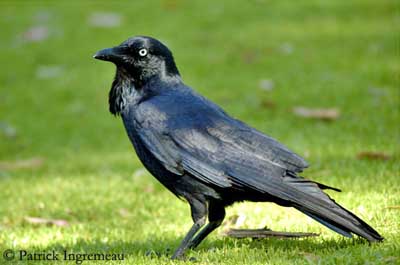
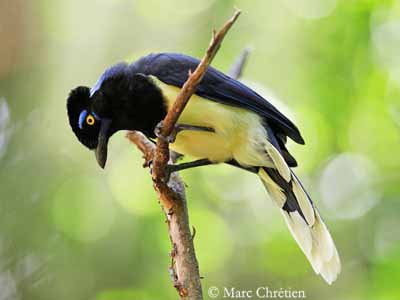
The diet varies locally and seasonally, especially for species living in arctic and temperate zones.
They can forage on the ground or in trees, but also on the seashore at low water.
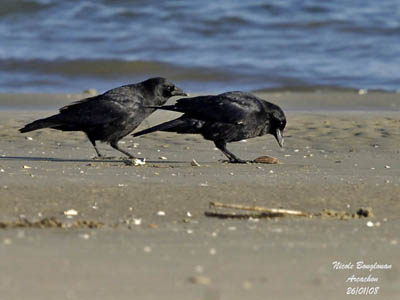
The Green Jay or Inca Jay (Cyanocorax yncas) uses several techniques such as foraging in trees by hopping along the branches, taking food items just above or below by stretching upwards or hanging down. It also performs sallies and pursues flying insects. It hovers for taking food from the tips of shrubs. It may often hang upside-down as tits or chickadees.
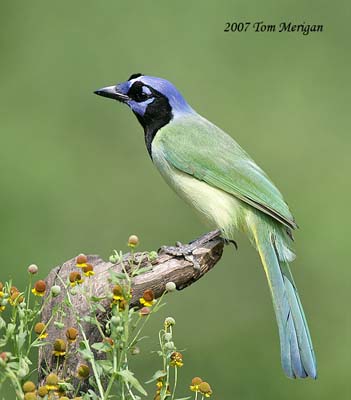
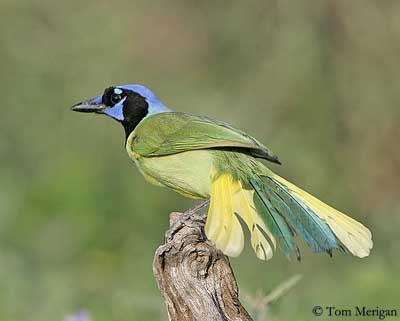
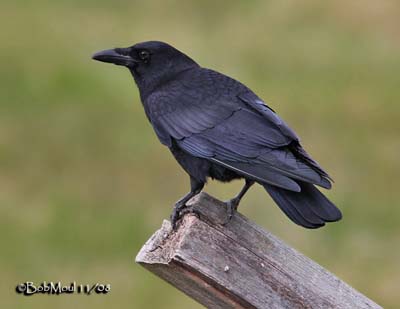
The Fan-tailed Raven uses stones to break open eggs.
But the most famous is the New Caledonian Crow, using tools to extract larvae from dead wood. This corvid is able to find and use tools such as a “hooked-twig” tool, a “hook-shaped wide end” and a “stepped-cut” tool, the latter made with pieces of Pandanus leaf. (See the card of this species for more information).
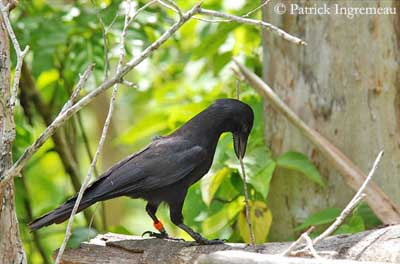
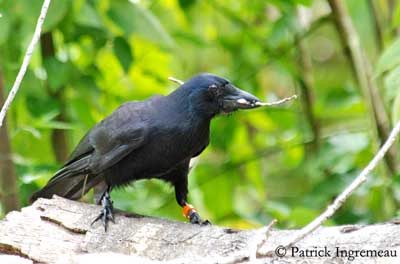
The Nutcrackers are specialized in the opening of conifer seeds.
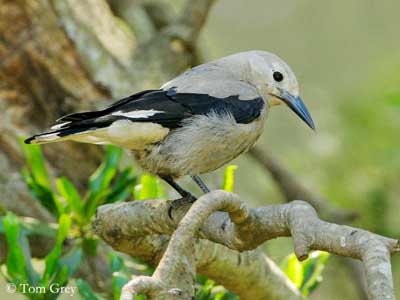
Each species feeds on different way, but in all species, the tendency is to find new solutions to each problem presented.
Corvids use several displays, as well to communicate as to threaten an intruder or to defend the territory.
During the threat display, the bird (here an Eurasian Jay) approaches with the head held up and bill pointing upwards, and the plumage sleeked. The snapping-bill is used too. In nest defence, all feathers are erected, but mainly those of head and back, and the bill is pointed towards the enemy.
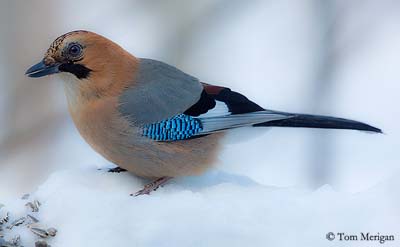
Corvids often chase larger birds, mainly raptors, away from their territories, and harass the intruder until it flies away.
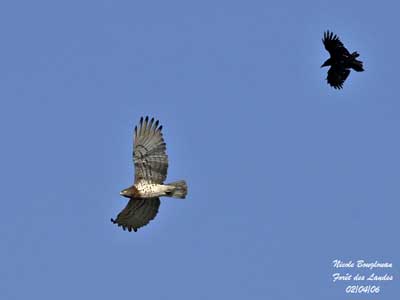
Carrion Crow chasing a
In sexual situations, the displaying bird moves around the other, and if the tail is long, it twists the tail towards it.
Common Raven performs rolling and tumbling aerial displays, both in courtship and territorial defence.
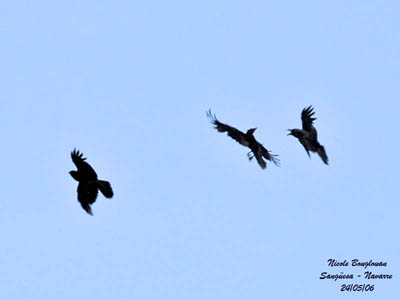
Numerous other displays occur in all species, according to the situation.
Corvids are monogamous with strong pair-bonds during the year, and often for the life. Social organization includes the defence of a territory by a pair or a flock. In this case, cooperative breeding may occur in an area defended by the family group, including non-breeding helpers. These helpers take part in all the nesting duties.
Some species breed in colonies, with nest very close to each other, often in large trees and on the same branch.
Others are mainly solitary nesters like most of the members of genus “Corvus”. They are territorial but some species tend towards the colonial breeding in some situations. The Rook is a truly colonial breeder and nests in treetops. Each pairs defends the small territory around the nest, and the colony feeds in the surrounding area.
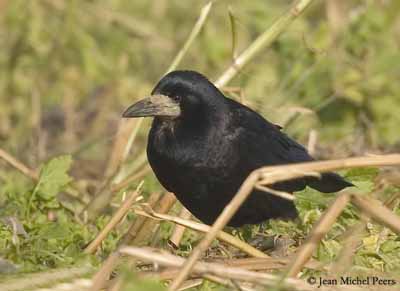
Corvids usually nest on trees, at the fork of a branch where the materials are firmly fixed. They can also use shrubs, or even the ground. In this case, the nest is concealed among the vegetation.
Other species such as Common Raven and choughs are found in cliffs, but they also may use artificial structures.
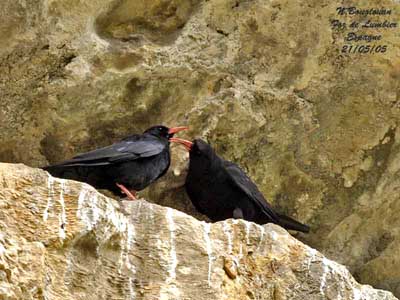
The nest is an open cup made with a platform of sticks and large stems, and lined with softer materials.
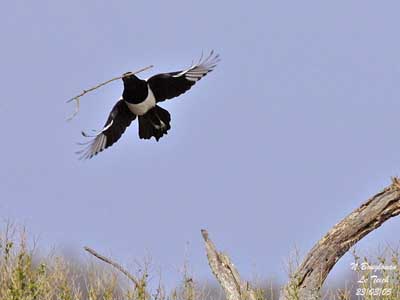
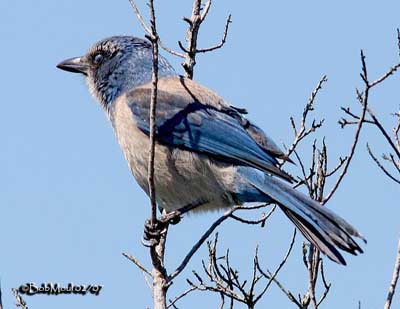
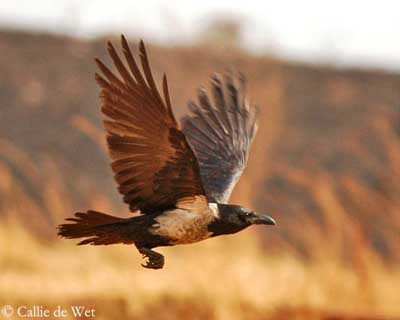
The young birds need long time before to fly. Some species are able to fly efficiently about 45 days later.
Corvids are good fliers. Members of the genus “Corvus” perform fairly long, continuous and strong flights with steady wing-beats.
The arboreal species, jays and magpies, have shorter wings and perform more laboured flight with frequent wing-beats.
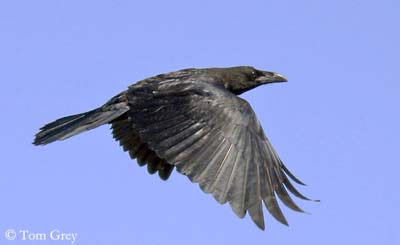
Corvids have stable or large populations throughout the world. However, they have suffered decreases due to habitat loss and destruction of these habitats for agriculture. The Red-billed Chough is now classified as Vulnerable in several parts of its range because this bird needs undisturbed grassy areas.
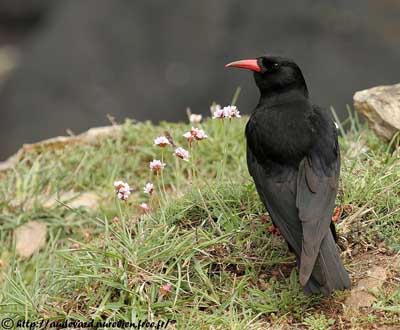
The restricted habitats of several species involve decreases too, like in Arabian Magpie (Pica asirensis) which habitat is threatened by development for tourism.
Deforestation and clearance of forests in south-eastern Asia threaten several arboreal species.
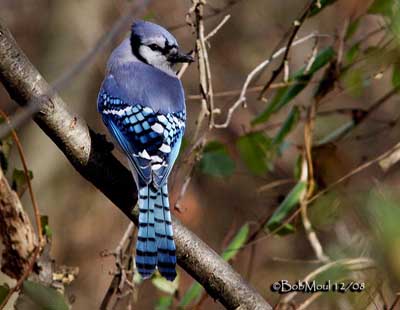
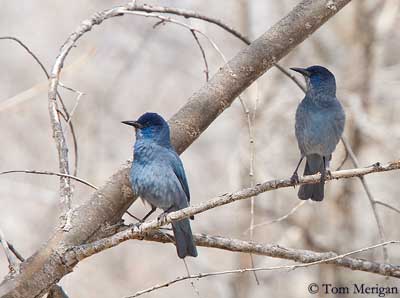
Corvids are now common in urban areas where they live close to humans. For this reason, these smart birds are very popular in human culture. We find them in folklore, legends, literature and variety of artistic expressions.
Their voices are used to accompany hard images associated with bad situations such as terror, dead, distress. Crows are frequently used as symbol of death in literature and painting.
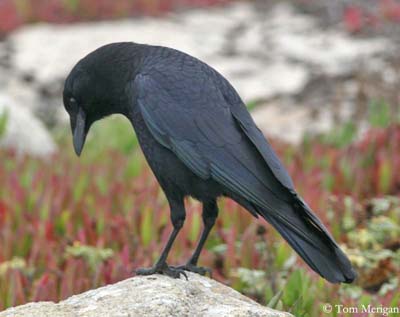
In addition to the close physical association of corvids and humans, there was a real interaction between them a long time ago.
Bernd Heinrich (Mind of the raven) argued that “the close relationship between ravens and wolves has been replaced by a bond with humans, the new dominant drive-hunting predator”.
